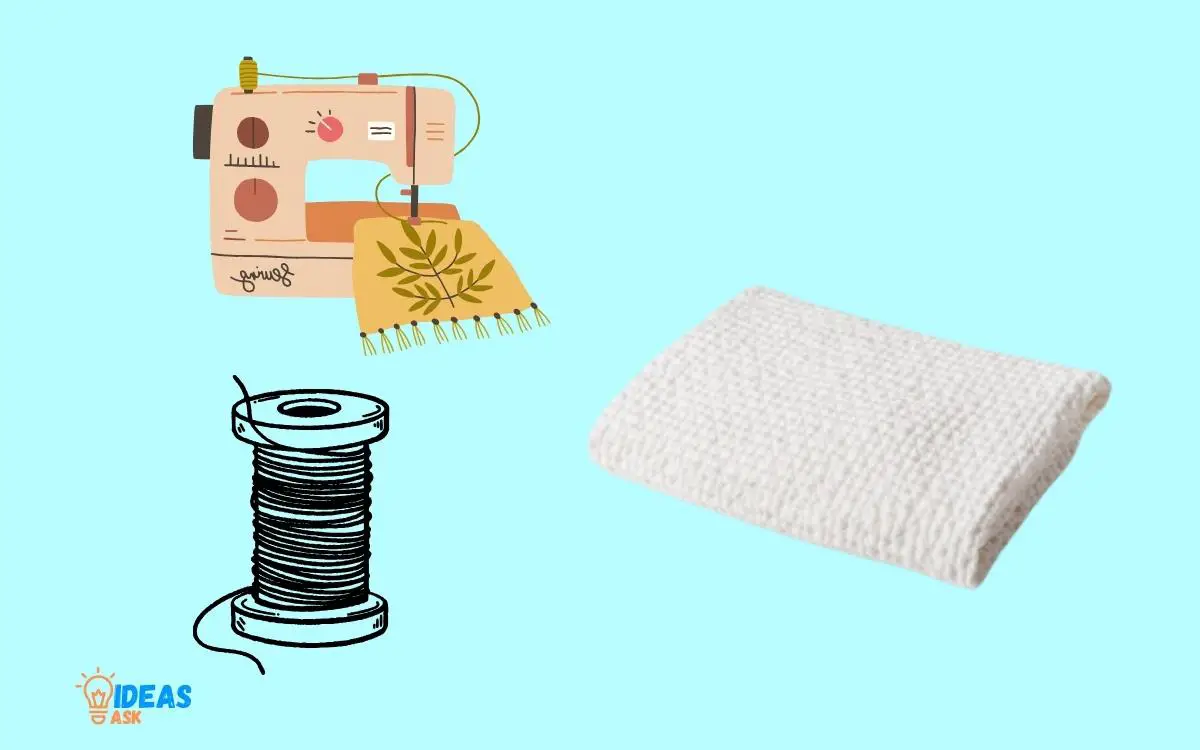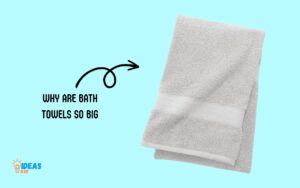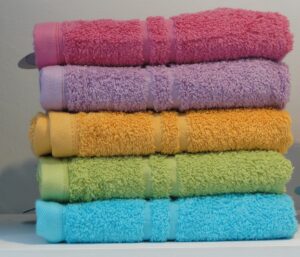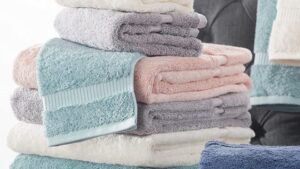How to Make Linen Bath Towels: 7 Easy Steps!
Making linen bath towels at home is a simple and cost-effective process that involves selecting high-quality linen fabric, cutting the fabric into the desired towel size, and sewing the edges to prevent fraying.
Linen is a highly absorbent and durable material, making it an excellent choice for bath towels. Making your own linen bath towels allows you to personalize the size, color, and design based on your preferences.
This involves purchasing linen fabric, designing the towel, cutting the fabric, and sewing the edges.
Making linen bath towels at home is not only economical but also gives you the opportunity to customize your towels to match your bathroom decor.
Plus, linen is a great choice for towels thanks to its superior absorbency and durability. It’s also naturally resistant to bacteria and mold, making it a hygienic choice for bath towels.

Key Takeaway
Step-by-Step Guide to Make Linen Bath Towels
Step 1: Choose Linen Fabric
When selecting linen fabric for towels, opt for 100% linen or a linen blend. Pure linen is very durable, absorbent, and softens over time. The best linen fabrics for towels are medium weight.
Step 2: Wash and Dry Fabric
Before sewing, pre-wash and dry your fabric on a hot cycle. This pre-shrinks the linen so your finished towels maintain their size after regular laundering.
Tips for Washing
- Use a gentle detergent
- Wash in hot 140°F + water
- Dry on high heat
Step 3: Cut Fabric
Measurements
- Standard bath towel size is 27 x 54 inches
- For folded hem allow 28 x 56 inches
Cut fabric pieces to size allowing for hemmed edges. Cut with grain of fabric, not on bias.
Step 4: Sew Hems
Finish edges by sewing narrow 1/4 inch double folded hems. This prevents fraying. Use a zigzag stitch for stretch.
Step 5: Sew Towel Body
With right sides facing, sew long edges of towel using 1/2 inch seam allowance. Finish seams by serging or zigzag stitch. Turn right side out.
Step 6: Add Hanging Loop
Sew hanging loop to corner so towels can be hung up after use. Use cotton cording or tightly woven ribbon.
Step 7: Wash and Dry
Wash and dry finished linen towels before first use. This completes shrinking process.
Towels are now ready for bath time!
Factors To Consider When Selecting Linen Fabric
When selecting linen fabric for making bath towels, it’s important to consider factors such as the quality, thread count, absorbency, and durability.
Additionally, look for fabric that is hypoallergenic and easy to care for, ensuring a comfortable and long-lasting towel.
Linen bath towels are not only luxurious but also highly durable, making them an excellent investment for your bathroom.
When it comes to selecting the perfect linen fabric for your bath towels, there are several factors to consider.
Let’s delve into the essential aspects that will help you make an informed decision:
Fibre Content
- Linen is made from the flax plant, which produces strong and absorbent fibers.
- Look for linen fabric that has a high percentage of flax fibers, preferably 100% flax linen.
- The higher the flax content, the more durable and long-lasting the bath towel will be.
- Avoid blends or synthetic fibers, as they may reduce the quality and performance of the towel.
Thread Count
- Thread count refers to the number of threads per square inch of fabric.
- Opt for linen fabric with a thread count between 80 and 120.
- Higher thread counts indicate a denser and smoother fabric.
- However, a thread count higher than 120 may result in a stiffer towel that lacks breathability.
Weave Type
- The weave type influences the texture, absorbency, and overall feel of the linen towel.
- Plain weave is the most common and offers good durability and softness.
- Herringbone weave adds more texture and visual interest to the towel.
- Waffle weave provides excellent absorbency and a luxurious, spa-like feel.
When selecting linen fabric for your bath towels, prioritize the fiber content, aiming for 100% flax linen. Consider a thread count between 80 and 120 for a balance of softness and breathability. Lastly, choose a weave type that suits your preference and desired functionality.
By paying attention to these factors, you’ll be well on your way to creating luxurious and durable linen bath towels for your everyday bathing experience.
Washing And Drying Instructions
Learn how to make your linen bath towels last longer with proper washing and drying instructions. With these tips, you can keep your towels soft, absorbent, and in excellent condition for years to come.
Recommended Washing Temperatures
- Use lukewarm water: Linen bath towels should be washed in lukewarm water to prevent excessive shrinkage or damage to the fabric.
- Stick to gentle cycles: Opt for a gentle or delicate cycle on your washing machine to maintain the integrity of the linen fabric.
- Avoid hot water: Hot water can cause linen fibers to weaken and break down over time, so it’s best to avoid using it when washing your towels.
- Consider hand washing: For a more delicate approach, you can choose to hand wash your linen bath towels using a mild detergent.
- Use mild detergent: To ensure the longevity of your towels, opt for a gentle and mild detergent specifically formulated for delicate fabrics.
- Skip fabric softeners: Linen naturally softens with each wash, so there’s no need to use fabric softeners that can leave residue on the fabric.
- Separate colors: To prevent color bleeding, wash your linen bath towels separately from other garments, especially dark or heavily dyed items.
- Dry cleaning alternative: If you prefer not to wash your linen towels at home, you can opt for professional dry cleaning as an alternative.
Proper Drying Methods For Maintaining Linen Fabric
- Air dry for best results: The ideal way to dry linen is by air drying. Hang your bath towels on a clothesline or lay them flat on a clean surface, ensuring proper airflow and minimal direct sunlight exposure.
- Avoid wringing or twisting: Linen fabric is delicate, so avoid wringing or twisting your towels to remove excess water. Instead, gently squeeze out the water and let gravity do the rest.
- Shake out wrinkles: Once your linen towels are dry, give them a gentle shake to remove any wrinkles. Linen has a natural propensity to resist wrinkles, so they should naturally relax during the drying process.
- Iron if desired: If you prefer a crisp, smooth look, iron your linen bath towels on the steam setting while they are still slightly damp.
- Store with care: When not in use, store your linen towels in a dry, well-ventilated area to prevent moisture accumulation and potential mold growth.
Remember, proper washing and drying techniques are essential for maintaining the quality and longevity of your linen bath towels.
By following these recommendations, your towels will stay soft, absorbent, and a luxurious addition to your bathing routine.
Storing And Maintaining Linen Towels
Linen bath towels can be easily stored and maintained by following these simple tips. Keep them clean by washing with mild detergent, avoid using fabric softeners, and air dry for longevity. Roll them instead of folding to prevent creases and store in a dry and well-ventilated area.
Linen bath towels provide a luxurious and eco-friendly addition to your bathroom. Not only are they absorbent and quick-drying, but they also add a touch of elegance to your daily bathing routine.
To ensure that your linen towels stay in pristine condition, proper storage and maintenance are essential.
We will explore folding techniques to prevent wrinkles and tips for storing and organizing your towels.
Folding Techniques To Prevent Wrinkles:
- Fold your linen towels neatly into thirds lengthwise: This helps to minimize the risk of creases and wrinkles. Start by folding one side of the towel towards the middle, then repeat with the other side. Finally, fold the folded edges together.
- Roll instead of folding for space-saving storage: If you have limited storage space, rolling your linen towels can be a great alternative. This method not only saves space but also reduces the chances of deep wrinkles.
- Avoid folding towels too tightly: Overly tight folds can lead to stubborn creases. Allow the fabric to breathe and relax by keeping the folds loose. This will help maintain the natural drape and texture of your linen towels.
Tips For Storing And Organizing Towels:
- Keep linen towels in a cool, dry place: Excessive heat and humidity can damage the fabric fibers and promote mold growth. Choose a storage area away from direct sunlight and moisture to preserve the quality of your towels.
- Use breathable containers or shelves: Avoid storing linen towels in plastic bags or airtight containers, as this can trap moisture and cause a musty odor. Instead, opt for open shelves or breathable fabric storage containers to maintain optimal airflow.
- Separate clean and used towels: Create designated areas or shelves for clean and used towels to prevent cross-contamination. This simple practice helps to maintain hygiene and allows for easy access to fresh towels.
- Rotate towel usage: By rotating the use of your linen towels, you can ensure even wear and tear. This prevents certain towels from becoming worn out while others remain unused. Additionally, regularly using and laundering your linen towels helps to maintain their softness and absorbency.
- Avoid using fabric softeners: Linen towels naturally become softer with each wash, and the use of fabric softeners can hinder this process. Instead, choose a gentle, eco-friendly detergent to preserve the natural texture and quality of the fabric.
By following these folding techniques and tips for storage and organization, you can prolong the lifespan of your linen towels and enjoy their luxurious feel for years to come.
Implement these practices into your bathroom routine to maintain the freshness and elegance of your linen bath towels effortlessly.
Conclusion
Making your own linen bath towels can be a rewarding and fulfilling experience. Not only will you have a unique and personalized towel, but you can also save money and reduce your environmental impact by using natural, sustainable materials.
By following the steps outlined in this blog post, you can easily create high-quality linen bath towels that are both practical and aesthetically pleasing.
Remember to select the right linen fabric, properly prepare and cut the fabric, and use the correct stitching techniques for durable and long-lasting towels.
Don’t be afraid to experiment with different colors, patterns, and embellishments to make your towels truly one-of-a-kind.
Whether you’re a seasoned sewer or a beginner looking for a fun and useful project, making linen bath towels is a creative and enjoyable endeavor that will enhance your bath time experience.
So why not give it a try and see the difference it makes in your everyday routine?






